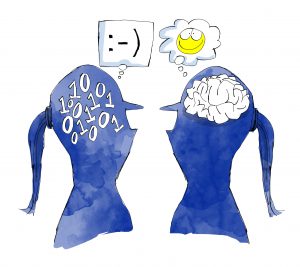Artificial Intelligence for beginners
Artificial intelligence uses computing power to process huge amounts of data. This gives computers the ability to perform, and outperform, when carrying out tasks that require a certain level of human intelligence. This includes things like visual perception, recognising speech, independent decision making and analysing information. A good example of AI in action is when machines are able to translate massive amounts of written data into multiple languages in a matter of seconds. For example, Skype’s online translator can help you communicate in eight languages for voice calls, and in more than 50 languages while instant.
Algorithm
 To make a computer do anything, you must write a program which tells the computer exactly what you want it to do. The computer then executes the program, following each step mechanically, to accomplish a required result. Algorithms are used all the time for making calculations, data processing, and automated reasoning. Some computer algorithms are designed to allow computers to learn on their own, facilitating what is called machine learning.
To make a computer do anything, you must write a program which tells the computer exactly what you want it to do. The computer then executes the program, following each step mechanically, to accomplish a required result. Algorithms are used all the time for making calculations, data processing, and automated reasoning. Some computer algorithms are designed to allow computers to learn on their own, facilitating what is called machine learning.
Machine learning gives computers the ability to learn without being explicitly programmed. Machine learning is like data mining, both systems look for patterns in data, but instead of extracting data for human analysis, machine learning uses algorithms to interpret the data and adjust programs accordingly, or make inferences from it. Bionic suits or prosthetic limbs for people who have physical disabilities are a good example machine learning. They are embedded with sensors which learn their wearer’s unique gait, adapt to their leg swing and speed, and mirror the individual’s natural walking pattern. Algorithms allow intelligent limbs to continue adjusting over time, adapting to different terrains and adding more power when the individual is tired.
Narrow AI  Narrow AI is designed to focus on one narrow task. This type of AI follows a set of rules – the algorithm – to answer a problem, without deviating or adapting the algorithm. A good example of narrow AI is a virtual personal assistant, which answers questions that it has been specifically programmed to understand.
Narrow AI is designed to focus on one narrow task. This type of AI follows a set of rules – the algorithm – to answer a problem, without deviating or adapting the algorithm. A good example of narrow AI is a virtual personal assistant, which answers questions that it has been specifically programmed to understand.
General AI
General AI (also sometimes known as strong AI) refers to the field of artificial intelligence that works towards providing AI that is more akin to human intelligence. General AI starts out knowing simple tasks and then adapts itself to solve a wide variety of problems faster and better. To do this you need a network of algorithms that can listen to feedback and modify themselves accordingly. General AI therefore refers to a computer that repeatedly improves itself until it becomes an ultra-intelligent, super-human machine that far surpasses human intelligence. Some scientists, like Stephen Hawking predict this could lead to an explosion of intelligence known as the “the technological singularity”, which will trigger runaway technological growth, resulting in unfathomable changes to human civilisation.
Bot
A bot is software that is designed to automate the kinds of tasks you would usually do on your own, like making a dinner reservation or adding an appointment to your calendar. The increasingly common form of bots, chatbots, simulate conversation. Another good example of a bot is a search engine spider which scans the internet and index’s new pages for a search engine



